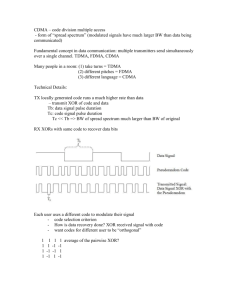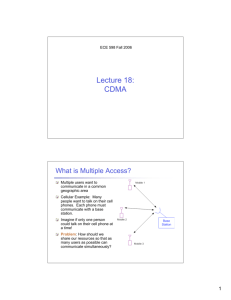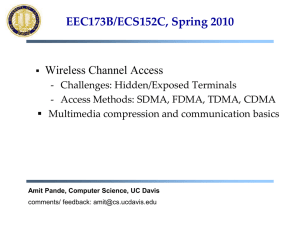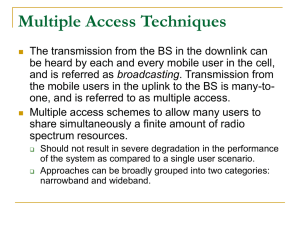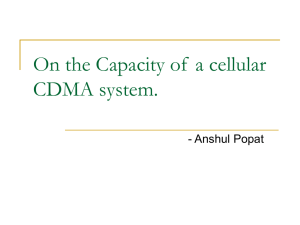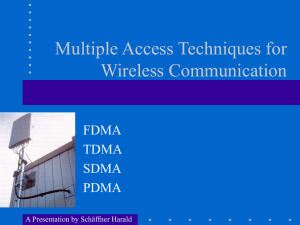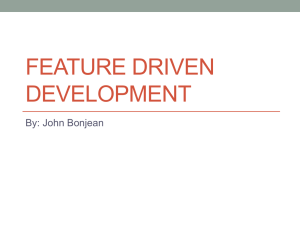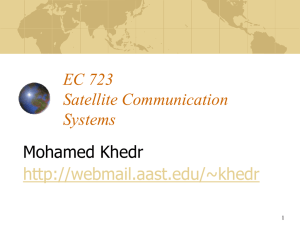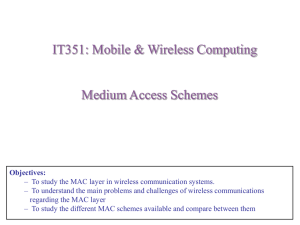RF MICROELECTRONICS BEHZAD RAZAVI
advertisement
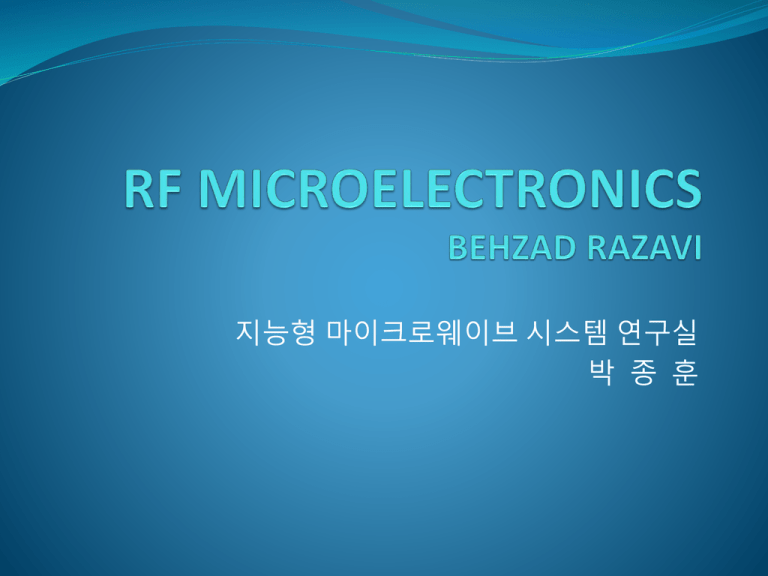
지능형 마이크로웨이브 시스템 연구실 박 종 훈 Contents Ch.4 Multiple Access Techniques and Wireless Standards 4.1 Mobile RF Communications 4.2 Multiple Access Techniques 4.2.1 Time-and Frequency Division Duplexing 4.2.2 Frequency-Division Multiple Access 4.2.3 Time-Division Multiple Access 4.2.4 Code-Division Multiple Access 4.3 Wireless Standards 4.3.1 Advanced Mobile Phone Service 4.3.2 North American Digital Standard 4.3.3 Global System for Mobile Communication 4.3.4 Qualcomm CDMA 4.3.5 Digital European Cordless Telephone Ch.4 Multiple Access Techniques & Wireless Standards 1. Multiple Access Techniques For a large number of transceivers in a network, additional methods are required to ensure proper communication among multiple users 2. Wireless Standard frequency bands timing data coding 4.1 Mobile RF Communications 1. Mobile System One in which users can physically move while communicating with one another e.g. pager, cellular phones, cordless phones Mobile unit Transceiver carried by the user Mobile, Terminal, Hand-held unit Base station Mobiles communicate only through a fixed, relatively expensive unit Channel Forward channel or downlink Reverse channel or uplink 4.1 Mobile RF Communications 2. Cellular System Frequency Reuse Physically far enough from each other can use the same carrier frequency MTSO(Mobile Telephone Switching Office) All of the base stations are controlled by a MTSO 4.1 Mobile RF Communications 3. Co-Channel Interference(CCI) How much two cells that use the same frequency interfere with each other This effect depends on the ratio of the distance between two co-channel cells to the cell radius and is independent of the transmitted power 7-cell pattern : approximately 4.6 Signal to co-channel interference ratio : 18dB 4.1 Mobile RF Communications 4. Handoff Since the power level received from the base station is insufficient to maintain communication, the mobile must change its base station and channel Performed by MTSO 4.1 Mobile RF Communications Handoff process Received level Drops below a threshold -> hands off Problem Fails with high Probability -> Dropped calls Solution Measure the received signal level from different base station Handoff when the path to the second base station has sufficiently low loss 4.1 Mobile RF Communications 5. Path Loss and Multipath Fading 1) Path Loss Signal power loss proportional to the square of the distance Direct Path / Reflective Path Loss increases with the fourth power of the distance 4.1 Mobile RF Communications 2) Multipath Fading Since the two signal generally experience different phase shifts, possibly arriving at the receiver with opposite phase and roughly equal amplitudes, the net received signal may be very small Moving objects tend to soften the fading -> P(Amplitude=0) ≈ 0 Reflected by Building, moving cars Fluctuations are quite irregular 4.1 Mobile RF Communications 6. Diversity Higher probability of receiving a nonfaded 1) Frequency diversity Multiple carrier frequency are used Two frequencies sufficiently far from each other 2) Time diversity Transmitted or received more than once to overcome short-term fading 4.1 Mobile RF Communications 7. Delay Spread Exhibit equal loss and unequal delays Second cosine factor relates the fading to the delay spread 4.1 Mobile RF Communications Difficulty Fading bandwidths of several hundreds of kilohertz Entire communication channel may be suppressed Delay spread ≈ bit period(digital modulating waveform) Rise to considerable intersymbol interference 8. Interleaving For lower the effect of errors, the baseband bit stream in the transmitter undergoes interleaving before modulation Interleaver scrambles the time order of the bits according to an algorithm known by the receiver 4.2 Multiple Access Techniques 4.2.1 Time-and Frequency Division Duplexing 4.2.2 Frequency-Division Multiple Access 4.2.3 Time-Division Multiple Access 4.2.4 Code-Division Multiple Access 4.2.1 Time-and Frequency Division Duplexing 1. TDD(Time Division Duplexing) Same frequency band is utilized for both transmit and receive paths Transmits for half of the time and receives for the other half E.g. walkie-talkies 4.2.1 Time-and Frequency Division Duplexing 2. FDD(Frequency Division Duplexing) Incorporates bandpass filters to isolate the two paths Transceivers cannot communicate directly 4.2.1 Time-and Frequency Division Duplexing 3. Merit and Drawback 1) TDD Merit RF switch with a lossless than 1dB, output power may be 100dB Two paths do not interfere Direct communication Drawback Weak nearby strong signals 2) FDD Drawback Leak into the receive band Loss of the duplexer is higher than TDD switch Leakage to adjacent channels in the transmitter output Occures when the power amplifier is turned on and off Despite the above drawbacks, FDD is employed in many RF systems 4.2.2 Frequency-Division Multiple Access FDMA Available frequency band can be partitioned into many channels Minimum number of simultaneous users is given by the ratio of the total available frequency band and the width of each channel 4.2.3 Time-Division Multiple Access TDMA Data stored(Buffered) for TF-Tsl seconds Advantage over FDMA PA can be turned off during the rest of the frame Digitized speech can be compressed in time Receive and transmit paths are never enabled simultaneously with FDD 4.2.3 Time-Division Multiple Access TDMA more complex than FDMA With the advent of VLSI DSPs, drawback is no longer a determining factor Combination of TDMA and FDMA is utilized 4.2.4 Code-Division Multiple Access 1. Direct-Sequence CDMA Certain code is assigned to each transmitter/receiver pair Walsh’s code Each codes are orthogonal 4.2.4 Code-Division Multiple Access Increases the bandwidth of the data spectrum by the number of pulses in the code Spectral Efficiency 4.2.4 Code-Division Multiple Access Upon multiplication Desired signal : returning to the original bandwidth value Unwanted signal : remains spread because of its low correlation 4.2.4 Code-Division Multiple Access CDMA is its soft capacity limit FDMA and TDMA the maximum number of users is fixed Power control 4.2.4 Code-Division Multiple Access 2. Frequency-Hopping CDMA 4.3 Wireless Standards All the details and constraints that govern the design of transceivers used in a wireless system 4.3.1 Advanced Mobile Phone Service AMPS Employs FDMA with analog FM and FDD Support approximately 830 users simultaneously Requires control and supervisory signals to initiate, maintain, and terminate a call 4.3.2 North American Digital Standard NADC Employs TDMA with π/4-DQPSK and FDD Each frame is 1944bits(40ms) Each time slot carries approximately 260bits of data along with 64 bits of control and synchronization information 4.3.2 North American Digital Standard First digital cellular system in the United States Most first-generation digital phones in the United States actually operate with both AMPS and NADC to provide a wider coverage for users IS-54(Interim Standard 54) Developed by the Electronic Association and the Telecommunication Industry Association 4.3.3 Global System for Mobile Communication GSM Unified wireless standard for Europe Supports many other services such as facsimile and ISDN Employs TDMA/FDD system using GMSK 4.3.4 Qualcomm CDMA Based on direct-sequence CDMA Proposed by Qualcomm, Inc., adopted for the North America as IS-95 4.2.4 Code-Division Multiple Access 1. Power Control Open loop procedure Perform a rough, but fast adjustment Mobile measures the signal power it receives from the base station and adjusts its transmitted power so that the sum of the two(in dB) is approximately -73dBm Pbs – k + Pm = -73dBm Pbs : power transmitted by the base station k : Receive and transmit paths entail roughly attenuation Pm : mobile output power 4.2.4 Code-Division Multiple Access Closed-loop procedure Base station measures the power level received from the mobile unit and sends a feedback signal requesting power adjustment This command is transmitted once every 1.25ms 4.2.4 Code-Division Multiple Access 2. Frequency and Time Diversity 3. Variable Coding Rate 9600, 4800, 2400, 1200 b/s 4. Soft handoff Make-before-break operation 4.3.5 Digital European Cordless Telephone DECT Allow connection to other systems such as GSM Provides mobility to local area network users Employs GFSK 24 time slots(12 for transmit and 12 for receive) Total duration of 10ms Each time slot contains 32 preamble bits 388 data bits 60 guard bits
